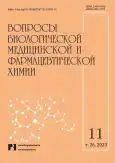Модификация методики определения общей антиоксидантной активности слюны
- Авторы: Григорьева Н.М.1, Кулешова М.В.1, Гробовой С.И.2
-
Учреждения:
- ФГБОУ ВО «Уральский государственный университет физической культуры»
- ФГБОУ ВО «Южно-Уральский государственный медицинский университет»
- Выпуск: Том 26, № 11 (2023)
- Страницы: 54-59
- Раздел: Биологическая химия
- URL: https://journals.eco-vector.com/1560-9596/article/view/623565
- DOI: https://doi.org/10.29296/25877313-2023-11-09
- ID: 623565
Цитировать
Полный текст
Аннотация
Актуальность. Состояние антиоксидантной системы имеет большое значение для спортсменов, чья деятельность часто сопровождается развитием окислительного стресса. При этом использование слюны в качестве объекта биохимического анализа является весьма перспективным, что связано с простотой забора биоматериала и характеризуется положительными корреляциями между отдельными показателями антиоксидатной системы слюны и плазмы крови. Известен ряд методов оценки антиоксидантной активности слюны, вместе с тем разработка простых методик, не требующих дорогостоящих реактивов и оборудования, остаётся актуальной проблемой.
Цель работы – модификация и адаптация метода определения общей антиоксидантной активности в слюне по степени ингибирования окисления твин-80 до ТБК-активных продуктов. Сущность модификации заключается в использовании реакции Фентона (Н2О2 + Fe2+) для инициации окисления.
Материал и методы. Объект исследования – образцы смешанной слюны. В серии I использовали методику определения общей антиоксидантной активности Л.П. Галактионовой с соавт. (1998), предложенную для плазмы крови, согласно которой окисление твин-80 инициировалось смесью сульфата железа (II) и аскорбиновой кислоты, после чего добавлялась слюна. В серии II проводили те же операции, что и в серии I, но в пробы дополнительно добавляли по 0,1 мл 2%-ного водного раствора перекиси водорода. Пробы инкубировали в темноте при 40 °С, при этом использовали пять параллельных постановок с различным временем инкубации: 1, 2, 4, 24, 48 ч. Общую антиоксидантную активность определяли по степени уменьшения образования ТБК-активных продуктов.
Результаты. Установлено, что добавление перекиси водорода к инициирующей смеси вызывает более интенсивное окисление твин-80 и образование ТБК-активных продуктов, чем в случае использования в качестве инициаторов окисления только сульфата железа (II) и аскорбиновой кислоты. При этом максимум образования ТБК-активных продуктов наблюдается через 2 ч, а не через 48 ч, как в оригинальной методике. Результаты определения общей антиоксидантной активности слюны модифицированной методикой также свидетельствуют в пользу 2-часового периода инкубации проб.
Выводы. Предложенная модификация методики определения общей антиоксидантной активности Л.П. Галактионовой с соавт. адаптирована для анализа слюны и позволяет сократить время проведения исследования.
Ключевые слова
Полный текст
Об авторах
Н. М. Григорьева
ФГБОУ ВО «Уральский государственный университет физической культуры»
Автор, ответственный за переписку.
Email: natalya-grigoreva-12@mail.ru
к.б.н.
Россия, г. ЧелябинскМ. В. Кулешова
ФГБОУ ВО «Уральский государственный университет физической культуры»
Email: natalya-grigoreva-12@mail.ru
к.б.н.
Россия, г. ЧелябинскС. И. Гробовой
ФГБОУ ВО «Южно-Уральский государственный медицинский университет»
Email: natalya-grigoreva-12@mail.ru
к.б.н.
Россия, г. ЧелябинскСписок литературы
- Chiappin S., Antonelli G., Gatti R., De Palo E.F. Saliva specimen: a new laboratory tool for diagnostic and basic investigation. Clinica Chimica Acta. 2007; 383: 30–40.
- Farnaud S., Kosti O., Getting S., Renshaw D. Saliva: Phy-siology and diagnostic potential in health and disease. The Scientific World Journal. 2010; 10: 434–56.
- Колсанов А.В., Чаплыгин С.С., Соколов А.В., Власов М.Ю., Мякишева Ю.В. Экспресс-методы определения показателей метаболизма в ротовой жидкости (обзор литературы). Клиническая лабораторная диагностика. 2018; 63(8): 489–95.
- Дудко Г.А., Дикунец М.А., Вирюс Э.Д., Крючков А.С. Альтернативные и перспективные объекты биохимического анализа в спорте (обзор литературы). Клиническая лабораторная диагностика. 2021; 66(11): 655–660.
- Lazaro A.S., Mussavira S., Bindhu O.S. Clinical and diag-nostic utility of saliva as a non-invasive diagnostic fluid: a systematic review. Biochemia Medica. 2015; 25(2): 177–92.
- Goswami Y., Mishra R., Agrawal A.P., Agrawal L.A. Salivary Biomarkers-A Review of Powerful Diagnostic tool. IOSR Journal of Dental and MedicalSciences. 2015; 14 (3): 80–87.
- Williamson S., Munro C., Pickler R., Grap M.J., Elswick R.K. Comparison of biomarkers in blood and saliva in healthy adults. Nurs.Res. Pract. 2012; Article ID 246178: 4.
- Бельская Л.В., Сарф Е.А., Косенок В.К. Корреляционные взаимосвязи состава слюны и плазмы крови в норме. Клиническая лабораторная диагностика. 2018; 63(8): 477–482.
- Овчинников А.Н., Дерюгина А.В. Ротовая жидкость как высокоинформативный субстрат неинвазивного исследования процессов липопероксидации и повреждения мышечной ткани у высококвалифицированных спортсменов в условиях физических нагрузок. Клиническая лабораторная диагностика. 2019; 64(7): 405–408.
- Powers S.K., Jackson M.J. Exercise-induced oxidative stress: cellular mechanisms and impact on muscle force production. Physiological Reviews. 2008; 88(4): 1243–1276.
- Конторщикова К.Н., Тихомирова Ю.Р., Овчинников А.Н., Колегова Т.И., Чуркина Н.Н., Кузнецова С.Ю. и др. Использование показателей свободнорадикального окисления в ротовой жидкости в качестве маркеров функционального состояния спортсменов. Современные технологии в медицине. 2017; 3: 82–86.
- Бельская Л.В., Сарф Е.А., Косенок В.К., Массард Ж. Антиоксидантная активность смешанной слюны человека в норме. Экология человека. 2017; 6: 36–40.
- Клебанов Г.И., Теселкин Ю.О., Бабенкова И.В., Любиц-кий О.Б., Владимиров Ю.А. Антиоксидантная активность сыворотки крови. Вестник РАМН. 1999; 2: 15–22.
- Борисенков М.Ф., Ерунова Л.А., Люсева Е.М., Поздеева Н.В. Суточная динамика общей антиоксидантной активности
- слюны человека. Физиология человека. 2007; 33(3): 137–138.
- Степанова Л.В., Вышедко А.М., Коленчукова О.А., Жукова Г.В., Кратасюк В.А. Использование биолюминисцентного тестирования слюны в оценке физической подготовленности спортсменов разной квалификации. Сибирское медицинское обозрение. 2017; 6: 63–69.
- Галактионова Л.П., Молчанов А.В., Ельчанинова С.А., Варшавский Б.Я. Состояние перекисного окисления у больных с язвенной болезнью желудка и двенадцатиперстной кишки. Клиническая лабораторная диагностика. 1998; 6: 10–14.
- Goldstein S., Meyerstein D., Czapski G. The Fenton reagents. Free Radical. Biol. Med. 1993; 15: 435–45.
- Дубинина Е.Е. Продукты метаболизма кислорода в функциональной активности клеток (жизнь и смерть, созидание и разрушение). Физиологические и клинико-биохи-мические аспекты. СПб.: Издательство Медицинская пресса, 2006; 20-23.
Дополнительные файлы






